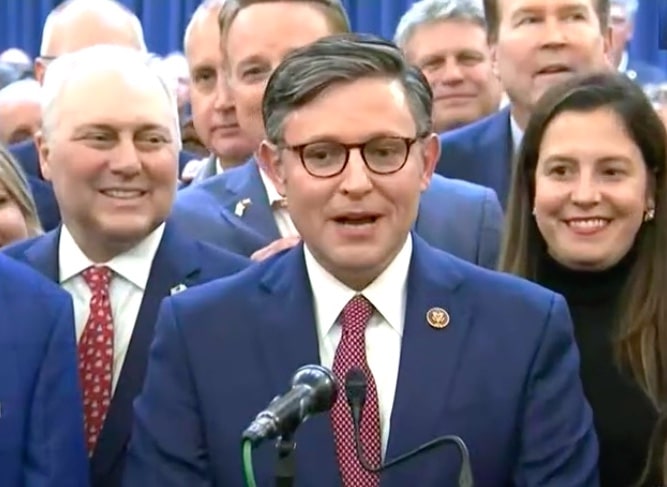House Speaker Mike Johnson (R-LA) unveiled a stopgap spending bill over the weekend aiming to avert a government shutdown at midnight Friday.
Johnson’s proposal extends funding for some government programs until January 19 while it continues to fund other programs until February 2.
“This two-step continuing resolution is a necessary bill to place House Republicans in the best position to fight for conservative victories,” Johnson wrote in a statement pinned on social media. “The bill will stop the absurd holiday-season omnibus tradition of massive, loaded up spending bills introduced right before the Christmas recess.”
The proposal does not include the $106 billion in new spending that President Biden requested to help fund Israel in its war against Hamas, Ukraine in its war against Russia, and beefed-up security on the U.S.-Mexico border.
“Separating out the CR [continuing resolution] from the supplemental funding debates places our conference in the best position to fight for fiscal responsibility, oversight over Ukraine aid, and meaningful policy changes at our Southern border,” Johnson said in his statement.
He added that, “The bill will stop the absurd holiday-season omnibus tradition of massive, loaded up spending bills introduced right before the Christmas recess.”
It was on December 23 last year that the House passed a $1.7 trillion omnibus spending bill for fiscal year 2023.
During a Saturday afternoon conference call, some hardline conservatives—normally resistant to temporary stopgap spending—indicated that they would give the recently-elected Speaker some room for passing legislation.
However, other hardliners, like Rep. Chip Roy (R-TX), expressed opposition to Johnson’s CR. Roy equated it with funding former House Speaker Nancy Pelosi (D-CA)-level spending and policies “for 75 days—for future ‘promises.'”
Over in the Democratic-led Senate, Majority Leader Chuck Schumer (D-NY) on Thursday teed up a vote this week on that upper chamber’s own stopgap measure, saying, “I implore Speaker Johnson and our House Republican colleagues and learn from the fiasco of a month ago. Hard-right proposals, hard-right slash and cuts, hard-right poison pills that have zero support from Democrats will only make a shutdown more likely.”
In September, then-Speaker Kevin McCarthy (R-CA) was ousted from the House leadership position after agreeing to send the initial stopgap to the lower chamber floor for a vote, where more Democrats voted in favor of its passage than Republicans—though it did avert a government shutdown by putting off the deadline to fund the federal government for fiscal year 2024 until this coming Friday night.
One Democrat in the Senate told CBS News, “It’s a good thing the Speaker didn’t include unnecessary cuts and kept defense funding with the second group of programs.”
However, White House press secretary Karine Jean-Pierre called Johnson’s proposal “a recipe for more Republican chaos and more shutdowns—full stop.”
In a statement she added, “House Republicans are wasting precious time with an unserious proposal that has been panned by members of both parties.”
The last government shutdown occurred December 2018-January 2019 and lasted for five weeks in a dispute between then-President Trump and Democratic Congressional leadership over funding his U.S.-Mexico border wall.
According to the non-partisan Congressional Budget Office, that shutdown—the nation’s longest ever—lowered the nation’s projected level of real GDP in the first quarter of 2019 by $8 billion, of which the CBO estimated only $5 billion was recovered.
In fact, this past Friday, the credit rating agency Moody’s Investors Service lowered its outlook on the U.S. government’s debt on Friday to “negative” from “stable,” citing the cost of rising interest rates and political polarization in Congress.
PHOTO: Mike Johnson, October 24
Read more exclusive news from Political IQ.


